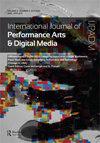表现性拓扑——来自内部的小手势
IF 0.9
0 THEATER
International Journal of Performance Arts and Digital Media
Pub Date : 2021-05-04
DOI:10.1080/14794713.2021.1934635
引用次数: 1
摘要
行为拓扑学是行为图解学的一部分,是我对认知及其与运动关系的持续艺术研究。在这篇报告中,我首先阐述了总体框架——表演图解学(Performative diagramatics)如何利用“作为读者的艺术家”的解读思维来追踪语义、语法、图解和溯因操作。我感兴趣的是展示对此类操作的更广泛的认识如何引起对认知多样性的关注。然后,我描述了作为柏林展览的一部分举办的行为拓扑研讨会。由芝加哥和魏玛的志愿者开发,行为拓扑通过两个连续的回路演变。第一个回路通过脚本、口头提示生成动作序列。第二个电路将这种紧急编排与反馈投影相结合,拓扑修改360度实时视频流。当参与者表演时,一个外化的图解空间出现,参与者进入双重意识,表演个人认知,同时为多节奏的联合编舞做出贡献。这样的图解空间是重构个人与环境之间关系的一种巨大的、象征性的可能性。从拓扑上理解,它是不变的和连续的。因为它不能被切割,所以不需要修补。它包含了一种围绕无尽的认知模式而建立的处于临界状态的愿景。本文章由计算机程序翻译,如有差异,请以英文原文为准。
Performative Topologies – small gestures from within
ABSTRACT Performative Topologies is part of Performative Diagrammatics, my ongoing artistic investigation of knowing and its relations to movement. In this report, I first lay out how the overarching framework, Performative Diagrammatics, draws on the interpreting mind of an ‘artist as reader’ to trace semantic, grammatical, and diagrammatic, abductive operations. I am interested in showing how a broader awareness of such operations can elicit regard for epistemic diversity. I then describe a Performative Topologies workshop held as part of an exhibition in Berlin. Developed with volunteers in Chicago and Weimar, Performative Topologies evolves through two successive circuits. The first circuit generates movement sequences through scripted, verbal prompts. The second circuit twins this emergent choreography with a feedback projection, topologically modified 360-degree video streaming in real time. As participants perform, an externalized, diagrammatic space emerges as participants enter a double consciousness, performing personal epistemes while contributing to a polyrhythmic, joint choreography. Such a diagrammatic space is one of great, symbolic possibility towards reconstructed relationships among individuals and their environments. Understood topologically, it is invariant and continuous. Because it cannot be cut, it does not require mending. It contains a vision of situated criticality built around endless modes of knowing.
求助全文
通过发布文献求助,成功后即可免费获取论文全文。
去求助
来源期刊

International Journal of Performance Arts and Digital Media
Arts and Humanities-Visual Arts and Performing Arts
CiteScore
1.70
自引率
0.00%
发文量
29
 求助内容:
求助内容: 应助结果提醒方式:
应助结果提醒方式:


